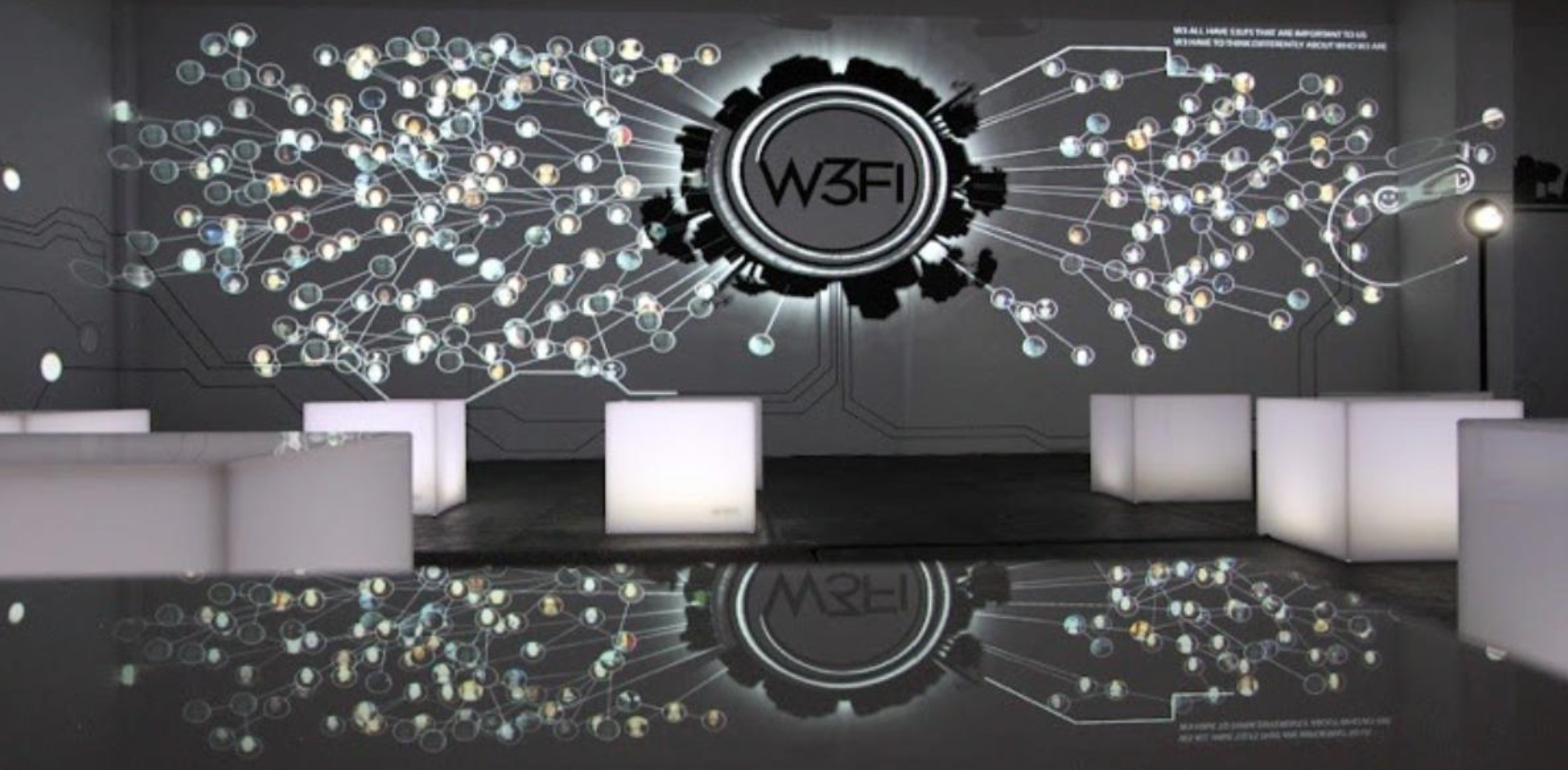Space Observer
Space Observer, 2010
commission for the City of San José, CA
installation at Norman Y. Mineta San José Airport - Terminal B
steel, aluminum, GFK composite, electronics, motors, LCD screen, camera
height: 8.5 m / 28ft, working diameter 1000 cm / 33ft
Video courtesy of the artist and the San Jose International Airport.
Space Observer, 2010 is a kinetic sculpture located inside Terminal B of the Mineta San José Airport in San José, California. This giant, three-legged, glossy white robot stands over 28ft tall and is reminiscent of a futuristic spaceship. Atop the 11ft tripod legs is the central body of the sculpture. This contains the ‘eye’ of the Space Observer; a large monitor that displays live video. Airport passengers are engaged by this elaborate, yet delicate-looking robot as it quietly spins, waving two propeller-tipped wings. The kinetic camera arms function like tentacles; collecting live video that is displayed on the monitor within the sculpture’s body, and another smaller monitor at the tail.
"It's kind of like this friendly insect or robotic thing that's greeting you… It moves and feels like something that might fly. I think they're going to think it's the coolest thing on Earth." – Goldstein, Barbara. Woolfolk, John (2010, April 16) Giant space robot headed for San Jose. San Jose Mercury News.
The embedded cameras explore the mezzanine level of the airport, symbolically welcoming both arriving and departing passengers. Space Observer is triggered by motion sensors and custom electronics, making movement reactionary and dependent upon the presence of its traveling audience.
All images are courtesy of the artists website.
Space Observer explores the interactivity between modern technology and humanity. Video data is not recorded or stored in the artwork, however visitors are aware they are being ‘watched’. The interactive sculpture’s cameras track movement; moving gradually closer to passengers as they are detected within the proximity of Space Observer. Space Observer assumes the role of playmate; attempting to chase and capture the passersby as they scurry in various directions below. From a simple set of parameters, a relationship is forged between human and machine.
Space Observer’s visual form echoes that of the architecture. The oversized robot blends seamlessly into the space; a reflection of the airport’s infrastructure. There is direct visual connection between the structure of Space Observer and other aeronautical devices; the propeller wings and tail fin are designed to resemble industrial airplane components. These types of aeronautical shapes are also used in Björn Schülke’s Luftraum #1, 2012.
All images are courtesy of the artists website.
Video courtesy of the artist and bitforms gallery nyc. To learn more about Schülke's work, please visit: bit.ly/q1SDQx bit.ly/xVhJ7D
Luftraum #1, 2012, is a black, solar-powered mobile that uses a wing-paddle for propulsion. As the sculpture stores energy gathered from the natural light in the environment, Luftraum #1, 2012 quietly spins. Luftraum means ‘airspace’. This kinetic sculpture is designed to emulate the flow of linear drawing. Schülke’s artworks have been greatly influenced by the Dadaist tradition, most notably artist Jean Tinguely. Tinguely’s kinetic sculpture Heureka was created in 1964 and is still in operation today. Both artists utilize industrial objects to develop ‘absurd machines’.
ZUERICH - Switzerland. Courtesy of Roland Sorg
All images are courtesy of the artist, Addie Wagenknecht
Artist Addie Wagenknecht has created a kinetic sculpture titled Asymmetric Love. This artwork of surveillance cameras in the form of a classic chandelier addresses the ubiquitous nature of surveillance in our current society, and the encroachment of technology into our everyday lives. Similar to Björn Schülke’s Space Observer, Asymmetric Love was designed to blend into the environment, merging technology and contemporary industrial design. Both Björn Schülke and Addie Wagenknecht tackle the issues of security and right to privacy, but do so in a non-threatening manner. Each artist effortlessly combines science fiction and surveillance instruments with interactivity.
Schülke’s kinetic works always possess a great deal of animism; they assume unique personalities, created by construction and mechanics that are seen as playful. The components to his devices are always simple and interact with their environment in interesting and unique ways.
“Björn Schülke designs objects that playfully transform live spatial energy into active responses in sculptural form. Born from a world of stuffed animals, spaceships, unusual scientific instruments and robots, some of these pieces also employ alternative energy sources – and speak powerfully to the environmental concerns of today.” - Salaud, Julien (Issue 9, Spring, pp. 69-72) Antenna.
The artist Björn Schülke is represented by Bitforms Gallery. Space Observer is a large-scale interactive sculpture on permanent display in the Mineta San José Airport.
Additional Press:
http://www.schuelke.org
http://voltashow.com/archive/volta7/exhibitors/bitforms-gallery/bjoern-schuelke/
http://hyperallergic.com/61351/our-robots-ourselves/
http://www.engadget.com/2009/04/20/space-observer-to-innocently-watch-you-at-san-joses-airport/
http://media.digitalarti.com/blog/digitalarti_mag/bj_rn_sch_lkes_kinetic_sculptures
http://www.art-agenda.com/shows/bjorn-schulke-at-bitforms-gallery-nyc/
Arnold, Willis, R. (2016, February 2) Kemper museum finds art in drone warfare and surveillance, St. Louis Public Radio.
Ashok, Mala (2010, July 20) Flight of fancy to Silicon Valley, Deccan Herald.
Baskas, Harriet (2010, July 14) High-tech art welcomes passengers at San Jose International Airport, USA Today.
Salaud, Julien (Issue 9, Spring, pp. 69-72) Antennae
Woolfolk, John (2010, April 16) Giant space robot headed for San Jose. San Jose Mercury News.








